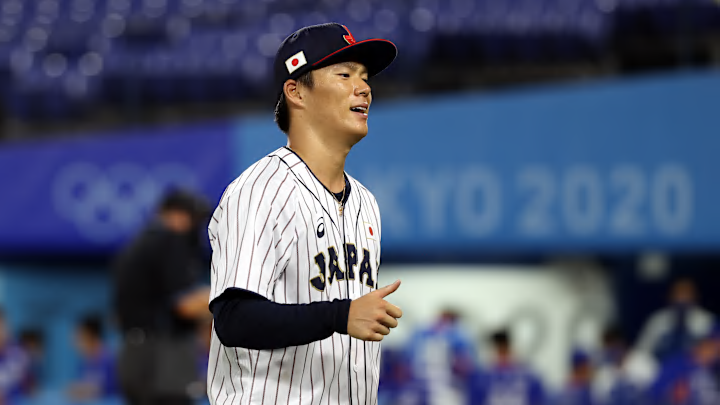Yamamoto's Repertoire
Frame and Size
Yamamoto is very undersized for a pitcher and stands at just 5-foot-10 and is listed at 176 pounds. This leads to some obvious concerns about his durability given that most MLB pitchers are 6-foot-2 or taller. Despite this, he has an impressive track record of health and has proven he can handle a full starter's workload. He has also shown he can hold his velocity and stuff deep into starts. The wear and tear of an MLB season can be difficult but it's fair to be project him for 170-180 innings annually, even at his size.
Fastball
What he lacks in size he makes up in arm talent as his fastball sits at around 95 MPH with lots of fun traits. The right-hander gets below-average extension toward the plate but throws from a low release height with a flat vertical approach angle that enhances the deception of the pitch. When you account for the standout carry (induced vertical break) on his fastball and its strong arm-side run it is immediately apparent that it is a plus pitch - or better - from a stuff perspective. He throws his fastball around half the time and there's an argument to be made that it's his best pitch. Japanese hitters struggled to make good contact on his fastball but the whiff rate was not as impressive as you might expect. There's two schools of thought here; one is that his fastball simply does not play up to it's strikeout potential; while the other more positive outlook is that the raw data is so good that an MLB organization should have no issue tweaking it to find more swing and miss. A fastball that gets lots of swings and misses is the framework of most of the best MLB starters so this will be of chief concern to interested teams.
It is true that NPB hitters are more contact-oriented than MLB hitters so you'll often see a Japanese pitcher come over and see an uptick in strikeouts. This does not seem to apply to fastballs as the miss rate tends to go down when Japanese pitchers come stateside. One hypothesis for this is that the NPB has a lot less high velocity arms than MLB so the Japanese arms that throw hard enough to come over tend to find that their fastball does not stack up as well as it used to. This often works the other way with secondary stuff. NPB hitters tend to be less aggressive than MLB hitters and therefore they are less willing to chase breaking balls and offspeed offerings which tend to get swing and miss. NPB hitters are also much more familiar with the splitter than MLB hitters given it's usage in their league. Kodai Senga saw a large uptick in whiff rate on his splitter/forkball when he came over and his fastball swing and miss rate stayed below average. Yamamoto's fastball grades out as significantly better than Senga's but this is an example of the general trend.
Splitter
Like a lot of Japanese pitchers, Yamamoto throws a great splitter. It sits at around 90 MPH and was excellent at getting weak contact on the ground as well as swings and misses. From a stuff and results perspective it grades out as a plus pitch and it will likely be his main secondary offering. It's not quite the standout pitch that Senga's splitter/forkball is but it's definitely a good pitch for him.
Curveball
Yamamoto throws a slow 77 MPH curveball with sharp, late break. It's a really pretty pitch to watch as he can get hitters to buckle and freeze on it. He is able to land it for a strike with more consistency than you might expect given the standout spin rate. An MLB organization might opt for trading some break for more velocity as a pitch like this does not grade out well from a Stuff+ perspective. He throws it 15 percent of the time and is willing to use it in a lot of different counts. There's a chance he backs off his curveball a bit in the States in favour of his sweeper (more on that later).
Cutter
His cutter sits in the low 90s and it functions as more of a weak contact inducer than anything. It's below average metrically but has it's use against righties and to set up his other pitches. He throws it around 10 percent of the time.
Sweeper
He'll mix in a sweeper very rarely. This may have the attention of MLB teams as it already grades out as an above-average pitch in a vacuum and it would make a lot of sense for him to throw it more in MLB. A lot more hitters bat left-handed in Japan than in MLB and this makes a right-handed pitcher throwing a heavy platoon offering like a sweeper an unwise decision. Perfecting his sweeper would give him another good swing and miss offering against righties which would be a significant boost to a potential area of weakness. It would not be all that surprising to see an organization make this change as a lot of early analysis on Yamamoto identifies this pitch as an area of untapped strikeout potential.
